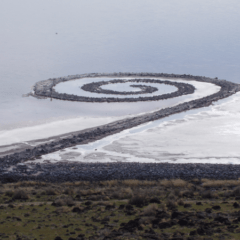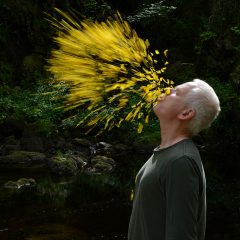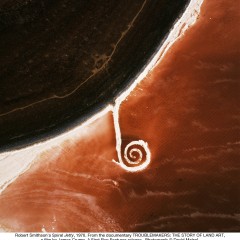Outside Amarillo, Texas, in a dusty basin which used to be the site of an artificial lake, there is a slight depression in the dirt where a small plane carrying Robert Smithson and his photographer crashed in 1973, killing all three passengers, including the pilot. They were surveying the area for Amarillo Ramp, a land art project that Smithson was commissioned to make for the property of Stanley Marsh 3.
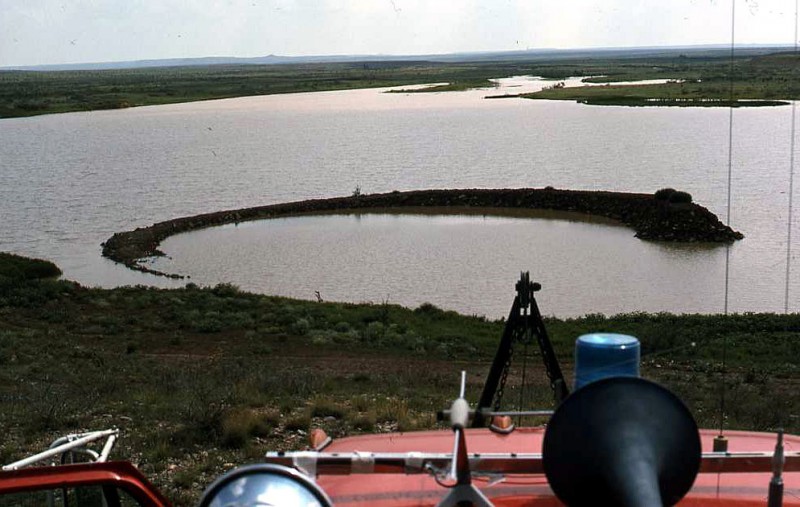
Since the ramp is on private property, a guide must take visitors out to see it. When I visited with a friend the day after the Summer Solstice, a youthful man, Jon, wearing a short sleeved, button-down shirt with the top few buttons left open and trendy, plastic sunglasses greeted us at Marsh 3’s ranch. Jon’s theory about the plane crash, which he explained to Chloe and me as we stood beside the fatal spot, is that they must have flown too close to the canyon wall next to us and been caught up in an airstream.
I made arrangements by e-mail to visit the Amarillo Ramp a few weeks before going out. The morning of, Chloe and I found breakfast at a local diner which felt cavernous compared to the East Coast places I’m used to. Chloe was thrilled to be able to smoke inside.
When it was time, we drove across town to the intersection given to me in e-mail directions. Along the side of a busy street, across from a facility selling storage sheds, was an unpaved driveway with an arched ranch sign that said “Toad Hall” and what looked like a John Chamberlain sculpture on the lawn. Down the driveway, we parked and met Jon who offered us water. We decided to take his pick-up to the ramp, and the three of us piled in front.
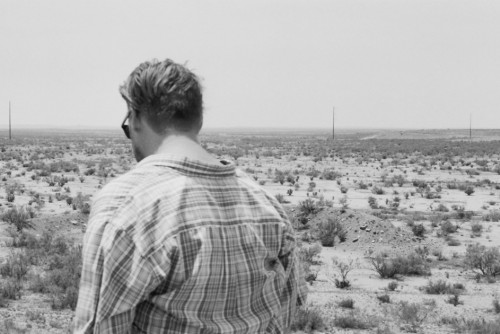
After driving on the main street for a short time we pulled onto a gravel road which we followed for ten or fifteen minutes. Jon quickly began to tell us the significance of Amarillo Ramp in relation to Smithson’s ouevre and to him personally. He described how, growing up in Amarillo, the Ramp and the knowledge bestowed on him by Stanley Marsh 3 were his only access to contemporary art. Gradually, his interest in art took on the role for him that religion played for most members of the Amarillo community.
After waving to two stern, fit men in full cowboy gear in the driveway of a cattle ranch, we were almost there. We parked the truck at the peak of a slight crest. Down below I could see the ramp, but almost missed it. After 40 years, it has begun to blend in with its natural surroundings. It struck me as larger than the photographs let on, and almost a different sculpture altogether. It appeared to be the soft-curving spine of a snake or an animal emerging from the ground. Unlike the crisp-edged form in photographs taken after its construction, the piece is now a semi-circular mound with gradually sloping sides. It is made of red shale, which gives the natural landscape its color. The ramp distinguishes itself from the dry, cracked ground by being a shade darker, resembling a blemish.
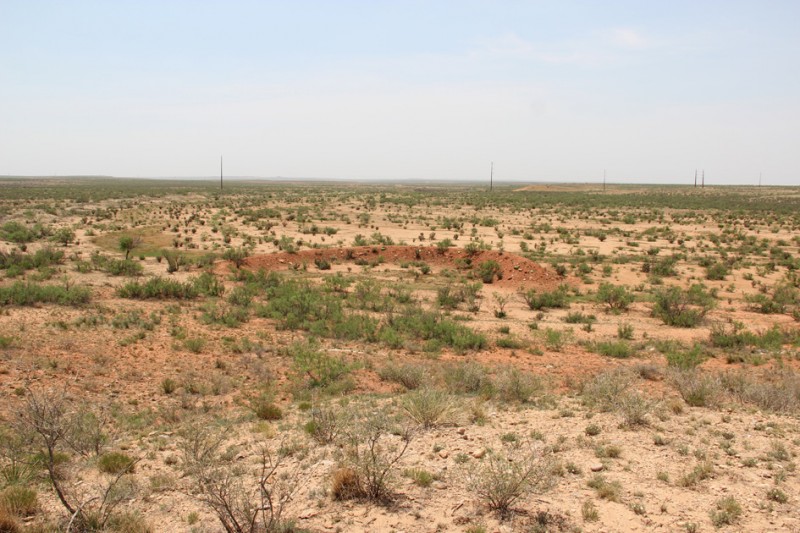
The midday sun bore down on the three of us as we approached the ramp. I walked carefully, picking my feet up over patches of brush or zig-zagging between them. When we got to the bottom, Jon told us proudly about the “Yeoman” irrigation technique adopted from Australian cattle herders used to create Tecovas Lake, which was originally here. In early photos of the artwork, Nancy Holt is standing at the end of the ramp, surrounded on both sides by rust-colored water. In Smithson’s sketch for the piece, there is a crooked shoreline which defines where the ramp touches the ground and where it sits in the lake. Squinting against the sun, it was astonishing to imagine water anywhere near that dry desert.
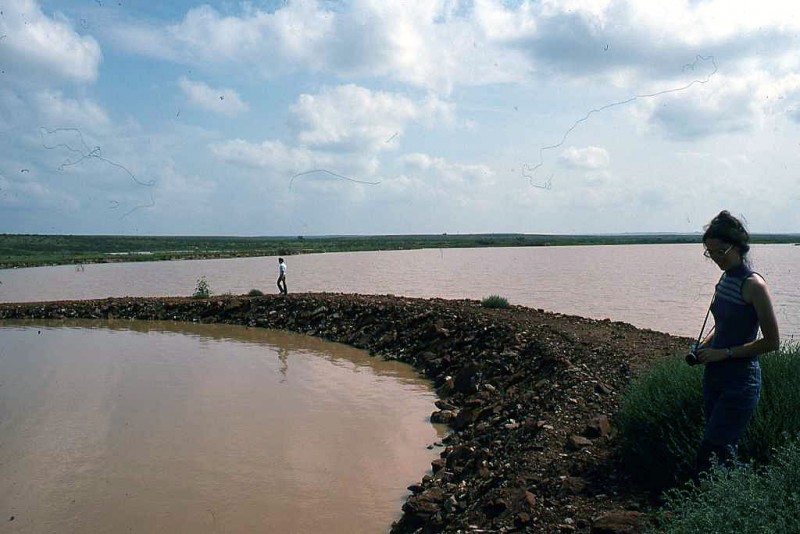
Among the first things I noticed about the piece were the sizable green spots throughout it. Jon called them “graffiti,” explaining that a former assistant of Marsh 3’s had painted some of the rocks that color and that there is debate about whether to paint them over or not.
There is a similar debate about Spiral Jetty in Utah: should it be restored to its original coloring? While Spiral Jetty has aged eloquently, Amarillo Ramp looks ragged. Jon said the degradation is part of the work; Smithson made time felt. He also divulged, however, that Nancy Holt (who had been married to Smithson for ten years when he died) told him that all the harping on entropy was B.S. if a foundation offered money to restore the sculpture.
Interestingly, while Smithson spoke frequently about the significance of entropy, he made a concerted effort to have Broken Circle/Spiral Hill in Holland maintained, although it was initially to be a temporary commission. (See Anja Novak’s essay in Art in Continual Movement, 2012.) I have to wonder, if Smithson saw Amarillo Ramp today in its disheveled shape, would his ego get the best of him and make him cringe or would he see it as a beautiful manifestation of nature?
Smithson viewed Amarillo Ramp as the conclusion to a trilogy of spirals: Spiral Jetty (1970), Broken Circle/Spiral Hill (1971), and Amarillo Ramp (1973). When the plane went down in 1973, he had placed stakes in the ground to mark the height at various points in addition to scrawling a hasty drawing of the shape on a scrap of paper. Nancy Holt and Richard Serra completed the project for him. The only aesthetic decision either of them made was to cast the sides at a slight angle rather than 90 degrees. Holt and Serra claim the piece is 100% Smithson’s, not theirs.
In his goal to push the context of visual art beyond the “void” of the museum — to connect contemporary art and contemporary life –Smithson’s Amarillo Ramp was, in my opinion, singularly most effective in its impact on Jon, who as a teenager confronted the earthwork and had to understand why it was art. In that questioning which sprung from resistance, the sculpture became a mobilizer that changed the course of his life. It is rare for a piece of art to come in such close contact with the actual events of one’s life. Jon’s experience is possibly the most precise manifestation of Smithson’s desires.
Spiral Jetty
One thousand miles northwest of Amarillo is Smithson’s iconic project, Spiral Jetty, on the Great Salt Lake in Utah. I can’t say if Spiral Jetty has personally affected anyone the way Amarillo Ramp touched Jon, but it certainly holds a prominent position in the collective art world imagination. On an overcast day in July, I drove out with my brother and a friend.
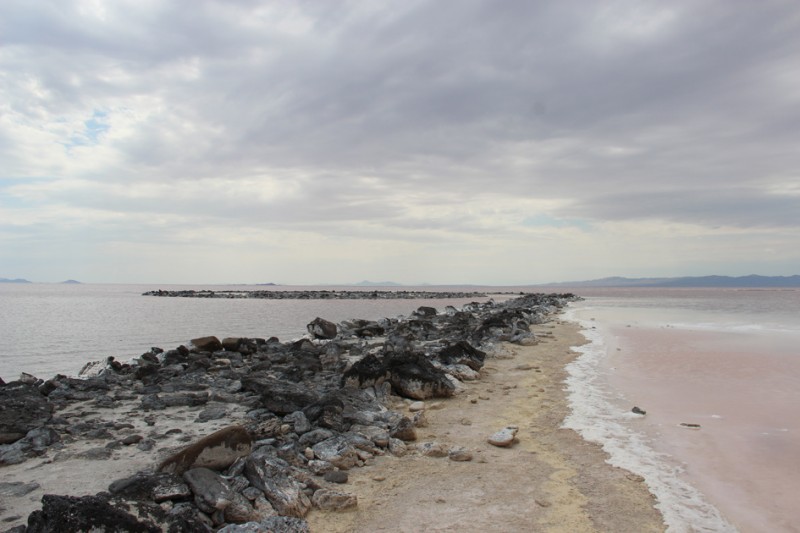
The road to Spiral Jetty departs from the Golden Spike National Historic Site, where the Union and Central Pacific railroads joined in 1869. Unlike the entryway to Holt’s Sun Tunnels — a two lane highway without service stops for ninety miles — the Golden Spike Site was populated with visitors, setting a different tone for the experience.
The roads leading out to Spiral Jetty are unpaved and unnamed, but there are occasional signs pointing visitors in the right direction, and Dia has thorough directions on their website. The Google Maps app on my phone was a pretty reliable navigator, too. All in all, it was an easy drive.
When we arrived we could park right in front of the jetty, and there were one or two others cars already there. The jetty reemerged from underwater in 1994 after being submerged for 24 years. Since then the water levels have fluctuated (the jetty is at 4197 feet above sea level), but on this day the jetty was fully visible.
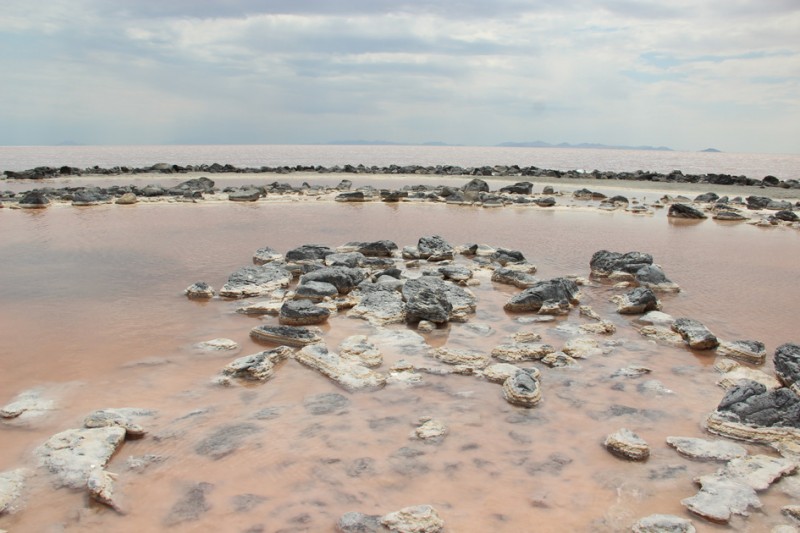
Built from basalt rocks, the jetty is a dark charcoal color which makes a tasteful combination with the reddish lake water. Around the edges, the rocks are capped with bright white salt formations and beige foam accumulates into funny, jiggling masses. The natural hue gradations and the complex surface textures are wonderfully interesting visual experiences.
We walked the full length of the spiral. Toward the innermost turns, I removed my shoes because the rocks were spread further apart. I dipped my feet cautiously into a few inches of water; the pink, crusted layers of salt crunched subtly under the pressure of my body. I was afraid of a sting, but it was not uncomfortable. When I pulled my feet out of the water, they, too, were encrusted with a light layer of salt. I backtracked my way to the base of the spiral where the jetty meets the shore and climbed a hill next to the parking area to get an aerial view before we took off.
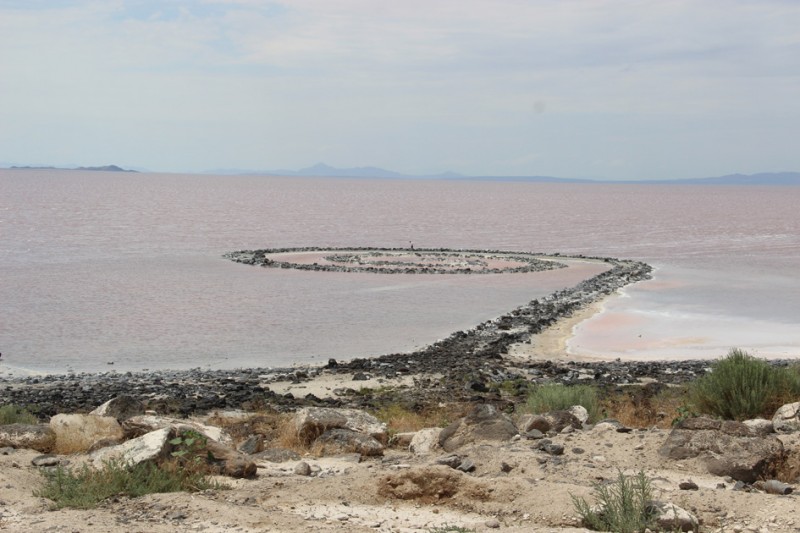
Relative to other Land Art projects I visited, where the macro view was most spectacular, the joy of Spiral Jetty was in the details. But I didn’t enjoy the jetty as much as the other Land Art projects because the journey getting there wasn’t a challenge and because three or four other carloads of tourists came while we were there. My favorite experiences– Amarillo Ramp and Sun Tunnels– were the sites that felt most remote, where no one else was, where, being alone with one or two companions, I felt like the artworks were there for me.
Around 2009, Lucy Lippard wrote in an introductory essay to Land/Art: “I’ve come to the reluctant conclusion that Land Art is for city people,” and my experience at the comparatively crowded Spiral Jetty forces me to believe she has a point. She continues, “It offers them/us an antidote to an urban landscape often crammed with art and visual competition.” So, Spiral Jetty, which has become a favorite pilgrimmage site for urban/arts-oriented individuals has lost some of the lure it had probably even ten years ago due to easier accessibility and increased visitation.
[This post has been updated to correctly attribute photos of Amarillo Ramp in 1974 to Blaise Tobia and the F&M Visual Resource Collection.]
—Emmy Thelander is an MFA painting candidate at Yale School of Art. Check out her website. Read other posts by Emmy.


